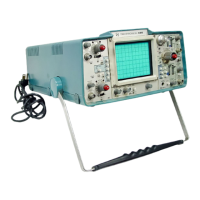Instrument Options—455/A2/B2
Inverter Circuit
The Start current is applied to the base of Q662 and Q666
through T661, R662 and R666. Since the transistors do not
have identical parameters, one will conduct before the other,
and start the inverter. Operating base current is provided
through CR658.
R635, R638 and T661 primary and secondary are the main
frequency-determining components of the inverter. C662
and C666 reduce the high frequency response and reduce
transients.
Feedback to maintain inverter operation is provided from
T700 primary to T661 primary through R635, R634, R639,
CR638 and CR639. Resistors R635 and R638 provide
frequency stability and current limiting. R639, CR638 and
CR639 compensate for differences in transistors and other
components. CR638 and CR639 conduct during different
inverter half-cycles and permit R639 to balance the drive
to T700.
C707, C708, and C709 are added to the secondary of T700
to provide optimum reduction of transients during inverter
operation.
Turn-Off Circuit
The voltage reference for the base of Q624 is set to about
16.9 volts by R613, VR613 and VR612. This sets the
junction of R615 and the emitters of Q622 and Q624 to
about 16.3 volts. Dc input voltages higher than 22 volts
cause increased current through R613, Q622 and R617.
Transistor Q624 is cut off by the increased voltage across
R617 and the resulting change across divider, R624-R625-
R622. This prevents current flow through R622 and cuts
off Q628. If the dc input voltage drops to less than 22 volts,
Q624 conducts, taking current from Q622 and causing less
drop across R617. This makes Q624 conduct more and
Q622 is cut off. Current flow through R622 turns on Q628.
Transistor Q628 then provides current to the gate of silicon
controlled rectifier Q632, which turns on and shorts out
the bridge rectifier. Capacitor C612 prevents Q622 from
turning on when the inverter is started, allowing the power
source time to recover after providing the initial start surge.
During 12 volt dc operation, no current flows through
VR612 and VR613, since their series drop of about 17 volts
exceeds the applied voltage. The base current of Q622
through R612, turns Q622 on enough to take all the current
through R615, which causes Q624 to be cut off. Therefore,
Q628 is cut off.
CR634, CR635, CR636 and CR637 form a bridge rectifier
which rectifies the inverter waveform to provide operating
power for the Turn-Off Circuit. Capacitor C633 filters the
inverter spikes to keep them from turning on Q632. Re
sistor R634 prevents C633 from charging to the peak-to-
peak inverter spikes.
Transistor Q632 turns on and shorts out the bridge rectifier
and the primary of T661, stopping the inverter. R632
prevents Q632 from being turned on by inverter noise.
R633 and C633 provide holding current for Q632 until the
inverter has stopped oscillating. CR633 permits rapid
charging of C633.
If 24 volts dc is accidentally applied when the Dc Voltage
Selector switch is in the 12 volt position, transformer T700
attempts to produce two times the correct feedback. This
is sufficient to cause VR632 to conduct. VR632 provides
the turn on current for Q632.
DC Input
External power is applied through P600. Diode CR601 is
normally reverse biased. If the wrong polarity external
power is applied, CR601 becomes forward biased and blows
fuse F600. Low-pass filter network T600, R600, C601,
C602 and C603 reduces transients to the dc source.
Option 7 Page 4
REV. A, OCT 1975

